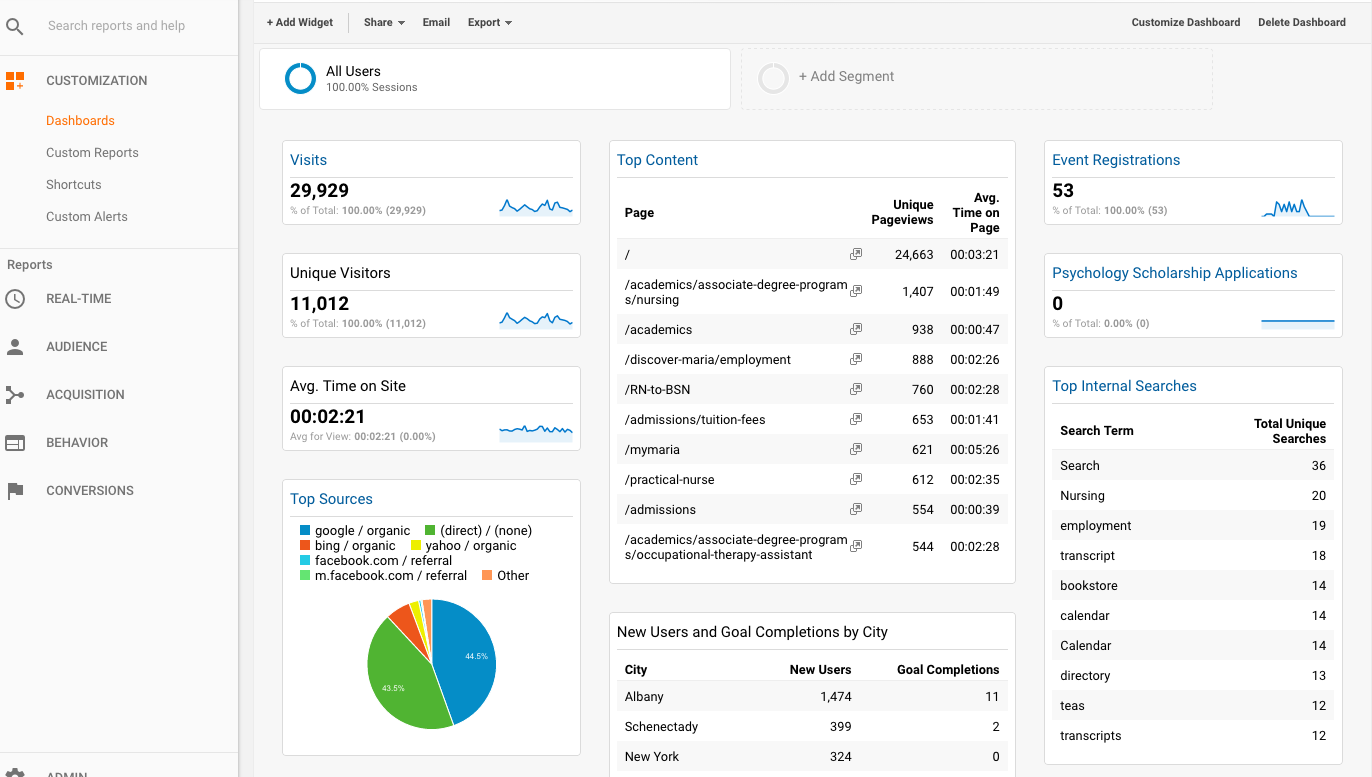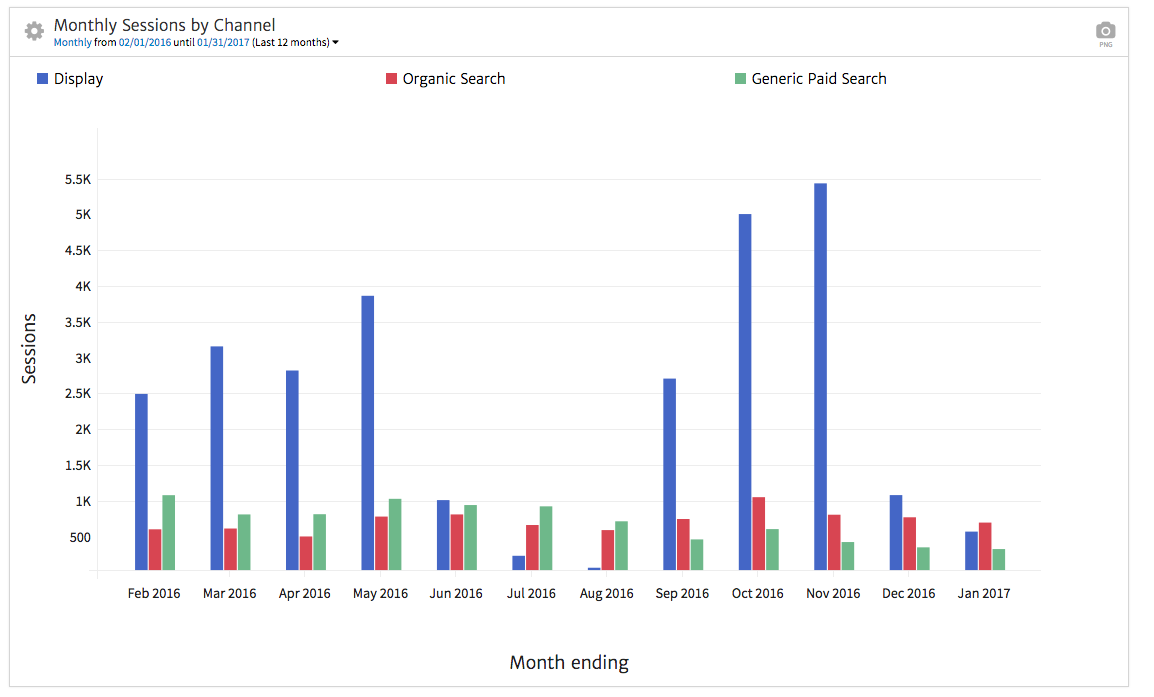
Google Analytics: Built-In Reports
A Google Analytics account is free and offers access to a wide range of data by default, including audience demographics, behavior, sources, and content. You can easily install the Analytics code on most websites by simply copying and pasting it into the right spot.
With custom configuration, you can also track conversion and revenue data. While tracking “thank you” pages for forms is relatively simple to set up, tracking revenue for ecommerce or SaaS sites can quickly become complex. Not every business model works well for full sales cycle tracking in Google Analytics, especially when a purchase takes place through an offline conversation months after the initial point of contact.
Dashboards allow you to see a quick snapshot of performance over a single timeframe, while segments and custom reports allow you to look at data on a deeper level than what is available in the default interface. For instance, you could look at top organic landing pages within a “blog” section of your site over the last six months.
Daniel Harris, Market Research Associate at Gartner Group’s Software Advice, uses Google Analytics heavily for measuring content performance and says, “Google Analytics custom reports are a quick way to do ad hoc analysis of trends.”
However, Analytics has its limitations in helping his team track to the point of final revenue. “Aside from quickly checking how a page or group of pages is performing, GA exports are of little use in content analytics. This is because we need to combine GA data with revenue data to get a full picture of content performance, and this can only be done in a dashboard, not within the GA interface (at least in our implementation).”
In addition, free Analytics accounts with high traffic volumes will sample data, meaning you may not see 100% accurate numbers when looking at certain timeframes or segments. Of course, at this point you can upgrade to Analytics 360 and avoid sampling, but the minimum pricing of $150,000/year is only realistic for enterprise level companies.
All conversion data is anonymous, which protects users but also inhibits the ability to tie in data from outside sources, like when a sale is closed from an online lead.
Finally, Google Analytics records data permanently with no option to “fix” data retroactively. If the tracking code wasn’t on a portion of your site, or if conversion tracking counted leads improperly, you can’t go back and correct the errors.
Understanding these limitations, let’s look at a few supplemental tools.
Supplemental Analytics Tools
To address the issues Google Analytics can’t handle, you can fill in the gaps with additional tools, which can assist with anything from competitor research to better conversion tracking.
Daniel says, “In addition to GA, our team also leverages BrightEdge. BrightEdge is a highly reliable tool, and I've found its reporting features for keyword volume to be on par with AdWords (and far more flexible). The BrightEdge data cube is also a great tool for benchmarking content performance against competitors.” Other useful tools for evaluating keywords and competitor data are SEMrush and AHREFs, which help provide perspective on the larger landscape of the web beyond your own data.
For tracking website performance, tools like KISSmetrics and Mixpanel can fill in the gaps in Google Analytics tracking. As we mentioned, Google Analytics keeps all personal user data anonymous, while these tools can tie actions to a specific person. For instance, you can look up an individual and see what pages they viewed, as well as connecting multiple conversion actions to that person. In addition, you can more easily add purchase data retroactively, associating it with an individual.
Implementing referral tracking into a CRM allows you to see what source led a user to a point of conversion. This way, you can look up a lead and determine if they found out about you via organic search, paid search, or another source.
Standalone Reporting Platforms
A standalone reporting platform can bridge the gap between the limitations of Google Analytics on its own and the need to integrate data from outside sources. By building a report within a platform like Megalytic, you can customize data on a level beyond what’s available in Google Analytics. In addition, you can upload spreadsheets and images to include data tracked in a CRM or another reporting platform.
Benefits above and beyond Google Analytics include:
- Feature multiple date ranges within the same report
- Apply different filters to separate widgets within a report (for instance, showing organic top pages and paid top pages)
- Choose from different charts such as bar graphs, line graphs, pie charts, tables, and more
- Integrate other sources like AdWords and Facebook
- Add commentary in sections throughout a report
- Create custom report templates that include client-specific branding
Referencing a recent report on analytics dashboard solutions, Daniel says, “Building reports and dashboards with GA data can be time-consuming and difficult. . . . For businesses without the advantage of a reliable system of record, and for businesses that haven't integrated their data warehouse for storing conversions/purchases/etc. with their GA implementation, services like those that Megalytic provides can be a game-changer, especially if valuable in-house resources are currently being dedicated to data integration."
Conclusion
As you review the options available for marketing reporting technologies, first consider your needs. What data do you need to track? How complex is the process of moving from to lead to sale? Next, review the platforms available to measure the data you require.
Finally, consider your reporting needs. What sources do you need to tie in? Who needs to be able to understand your reports? By tying platforms together and carefully tracking data, you can succeed with measurement and reporting that proves a return on investment.



